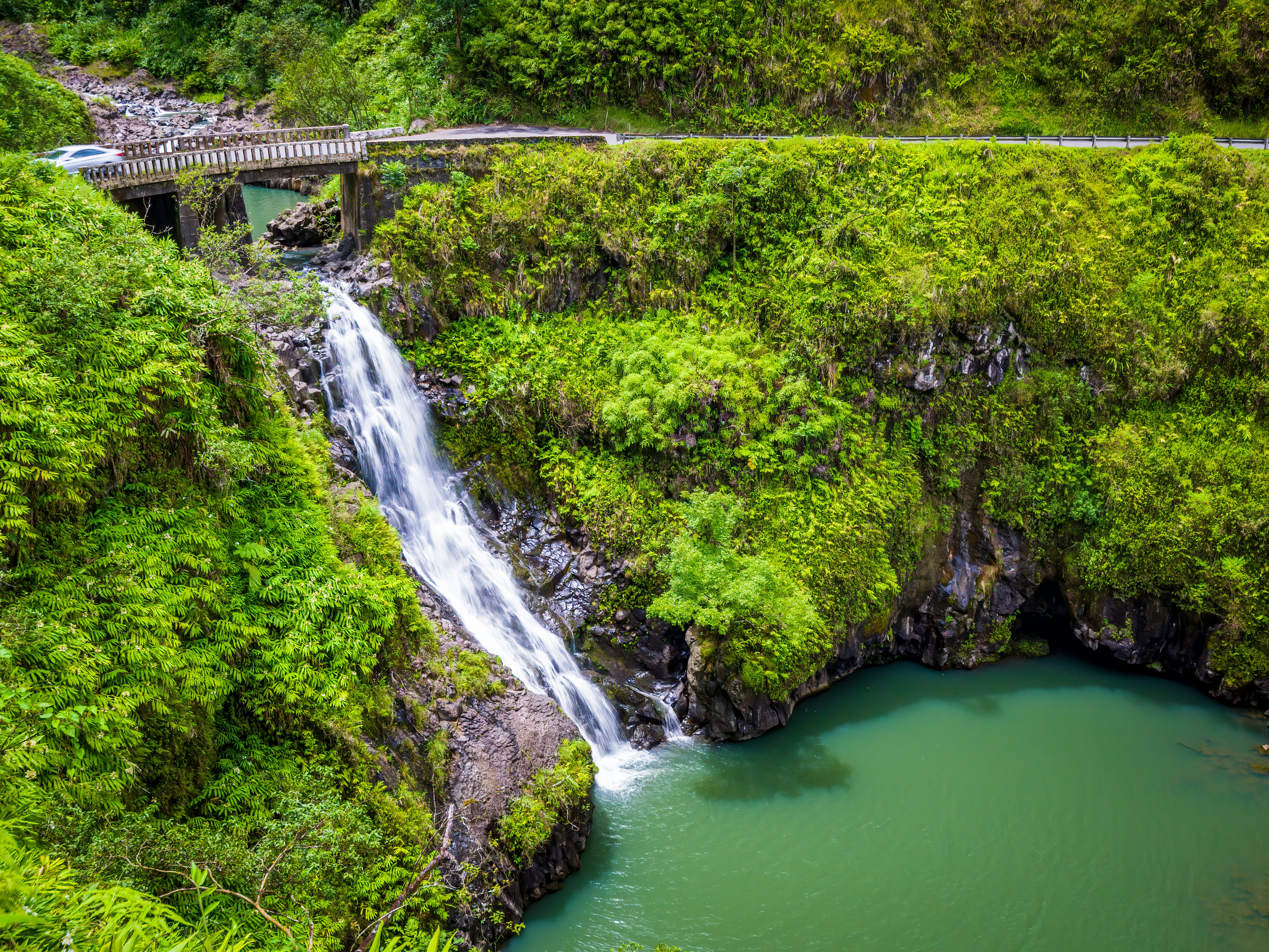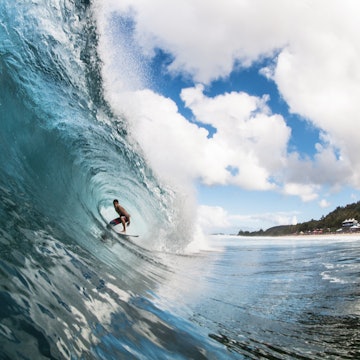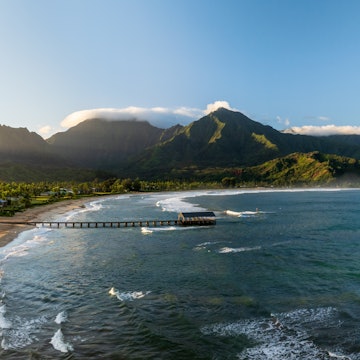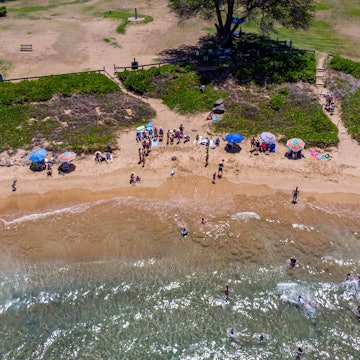

Dawn at Haleakalā National Park. Eleseus/Shutterstock
The island of Maui is characterized by a delicate balance of lively nightlife, esteemed restaurants and mai tais on the beach contrasted against secluded adventures, rugged terrain and rich Native Hawaiian culture.
Maui has been through a lot historically. In 1898, the Kingdom of Hawai‘i was annexed by the United States and later became a state, putting an end to the Hawaiian monarchy and Native Hawaiian autonomy on their own homeland. In the years that followed, foreign businesses exploited the lands through plantations, development and tourism. And on August 8, 2023, Maui experienced wildfires that killed more than 100 people and destroyed more than 2200 structures, including significant historic and cultural sites.
Tourism to the island has been a long-debated subject, with residents trying to find the most sustainable way to preserve the land while also supporting the economy. When visiting Maui and its neighboring islands, remember to educate yourself on the culture, respect the land and its people, and spend your money wisely by patronizing local businesses.

When should I go to Maui?
Maui is beautiful all year round, so there isn’t a wrong time to go. People typically like to plan a vacation during Maui’s winter whale-watching season, from November to April. Some activities, like those involving recreational watercraft and parasailing, aren’t available during this time to protect these aquatic visitors. Even though it can rain at any time of the year, wet weather may be more prevalent during these months, causing hiking trails to be inaccessible. For surfers, though, winter has the best conditions.
Winter, spring break and summer are the high season, when Maui is the most busy and expensive. Low season is during spring (excluding spring break) and fall, and while it's generally less busy and expensive during these seasons, Maui is comparatively expensive all the time.
Hurricane season is from June to November, so consulting the weather forecast before a trip is always a good idea.

How much time should I spend in Maui?
Your time in Maui likely depends on how much money you have and how far you’ve come.
You can have a solid trip in three days: one day spent shopping and sightseeing, another day going on an adventure (like driving the Road to Hana) and the last day relaxing at the beach or a pool.
However, more adventurous travelers will probably prefer to stay up to a week, checking out popular hiking trails like the Waiheʻe Ridge Trail, trying water activities like surfing lessons, spending time in each part of the island and hitting up local food spots.
More than a week and costs will start to add up.
Is it easy to get in and around Maui?
The easiest way to get around Maui is to rent a car. Public transportation doesn’t take you everywhere, rideshare apps can be unreliable, and Maui isn’t especially walkable. With a car, you’ll have more freedom to explore whenever you want to.
Maui’s roads are pretty straightforward. There aren’t any multilane freeways, and the top speed limit is 55mph.
The most difficult scenarios you'll encounter when moving around the island are winding roads, like the Road to Hana, or very narrow or one-lane roads. In these situations, just take it slow and drive carefully.

Top things to do in Maui
A common saying in Hawaii is “mauka to makai” – meaning mountain to ocean. And a good way to experience the island is to do things in both mauka and makai.
Drive to the summit
Driving up to the Haleakalā summit to watch the sunrise is Maui’s top mauka activity. The mountain stretches up about 10,000ft, displaying breathtaking views and a unique landscape. It also holds great significance in Hawaiian culture, and the Haleakalā National Park preserves the environment for endemic plants and animals.
Get out on the water
Going out on a boat is a great makai activity. Whether it’s a whale-watching charter, a snorkel trip, a solo paddle or a dinner cruise, you’ll enjoy your time on the water while getting an exclusive view of the island.
My favorite thing to do in Maui
As a Native Hawaiian born and raised in Maui, I miss the food the most whenever I am away, so my first mission once I step off the plane is to buy some poke (pronounced "poh-keh," not "po-kee") at Foodland. I pair it with some laulau (pork or chicken and salted butterfish, wrapped in taro and ti leaves and steamed), lomi-lomi salmon and poi (steamed, mashed taro).
Maui has a booming food truck scene, so it won't be long until you come across a parking lot with a few trucks and an eating area. These food trucks have become the primary option for breakfast, lunch and dinner, as you can get a restaurant-quality meal just by walking up to the window, and the range of cuisine is extensive.
For restaurants, I frequent Tin Roof, and I also really enjoy Makawao Public House and Casanova. Finally, Mama’s Fish House creates an elevated dining experience set right in a cove.

How much money do I need for Maui?
Hawaii is known to be an expensive destination. Just buying a plane ticket to Maui can be hundreds or even thousands of dollars depending on where you’re coming from.
Night at a basic hotel, hostel or short-term rental: $100–250
Night at a resort: $700 and up
Plate lunch: $15–25
Gas per gallon: $4–5
Prepare to budget over $1000 per person, depending on how long you’re staying and what you plan on doing. An average of $2500 to $3000 per person for a one-week trip is typical if you’re staying in an average hotel, using a rental car and doing multiple activities. For a couple or family, it may be less per person, considering you’re bundling some costs, like staying in the same hotel room.

Pack based on your activities
Maui can feel very humid to a lot of visitors, so pack clothing that will keep you cool. However, if you are visiting Haleakalā National Park or staying in the upcountry Maui area, you’ll most likely need warmer clothing. Maui is very windy overall, so a windbreaker jacket is good to have on hand.
Pack smart clothing if you'll be going to certain places such as restaurants – don’t be fooled by the relaxed aura of the island; you can’t dress casually or like you just came from the beach everywhere you go.
For footwear, a pair of hiking or activity shoes and a pair of slippers (flip-flops or sandals) are a must.
It is prohibited to bring many plants and foods to the Hawaiian Islands, so consult the state’s requirements for what’s permitted.
Be sensitive to the aftermath of the wildfires
The wildfires mostly burned through the town of Lahaina, located on the west side of Maui, and displaced many of its residents to other parts of the island. A vacation to Maui is OK, but visitors should remember to remain sensitive to this recent disaster during their time on the island.
Avoid the burn site or, if you have to drive through it, don’t gawk or exploit it. Avoiding the burn site is easy, as it covers a small part of the island and there are plenty of things to do in other areas.
Support local businesses – especially ones affected by the fires – by shopping at farmers markets or farms instead of grocery stores and eating at food trucks or locally owned restaurants. On top of that, generously tip anyone who serves you. You can even donate to specific causes, including food banks, the Humane Society or Native Hawaiian nonprofits.
Look for hotel-style accommodations instead of short-term home rentals. This helps relieve some of the stress on local housing needs. Avoid buying housing or properties, as homes for Hawaiians and locals are scarce.
Learn about the fire and how it affected Maui’s people. Look at a map to learn about the landscape and what parts of the island were affected. If you’d like to do more to help, check out these volunteer opportunities.

Approach your visit with respect
Hawaii is home to a rich cultural heritage, so showing respect is crucial. The “aloha spirit” is not simply gained; it is earned. Start by educating yourself on the culture and history. Some good topics to research are the Kingdom of Hawai‘i, the overthrow of the Kingdom of Hawai‘i, Native Hawaiian culture, Hawaiian sovereignty and the Hawaiian renaissance.
Asking locals and Hawaiians questions will further your knowledge and make your trip more enriching and immersive. Just avoid vacuous questions like “Do you go to the beach every day?” or “Do you live in a grass hut?”
When on vacation, it’s easy to let your mind slip into autopilot, but be courteous and avoid getting in anyone’s way (especially if you are in a big group) or being too loud.
You may come across a marked sacred cultural site; in this case, obey the signage and keep a respectful distance.
Locals are all about showing kindness to one another, often waving or throwing out the shaka gesture in certain scenarios. For example, if a car lets you cross the street, or if you’re driving and another car lets you merge, acknowledge them with a wave or shaka – and don’t forget to smile.
"Hawaiian" has a specific meaning
“Hawaiian” refers to the people of Native Hawaiian descent, the Indigenous people of Hawaiʻi who stem from ancestors who inhabited the land before contact was made by any outsider. “Hawaiian” does not refer to anyone who simply lives in the state of Hawaii.
Hawaiians have their own language, their own traditions and their own beliefs that have been practiced since the dawn of time. The people of ancient Hawaiʻi were highly skilled, intelligent and dignified, essentially creating their own science to care for and protect the land as well as voyage across the Pacific. The Hawaiian monarchs and the Kingdom of Hawaiʻi were established in the 1800s, and Hawaiʻi was recognized as an independent nation by the United States until the overthrow of the kingdom. Fun fact: the ʻIolani Palace was the first royal residence in the world to be lit by electricity.
However, Hawaiians and their culture experienced near extinction in the early 1900s due to ethnocide by foreign settlers – Hawaiians were punished and banned from speaking their native language, dancing hula or practicing anything related to the culture.
The population of Hawaiians has been slim. Their numbers have grown over the years, but it is rare to find someone who is full Hawaiian. Within the past few decades, strong activists and nonprofit organizations have led a renaissance of Hawaiian culture. However, Hawaiians continue to fight for their rights.















